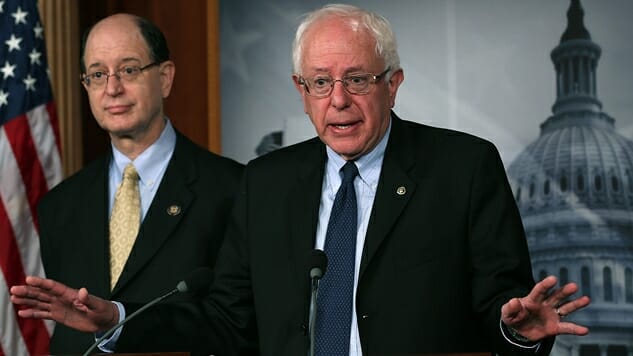Bernie Sanders Wants to Break Up Wall Street Giants Like Goldman Sachs
Photo by Mark Wilson/Getty
Fresh off his assist of successfully amplifying organized labor’s relentless efforts to pressure Jeff Bezos into paying his Amazon workers a higher wage, Bernie Sanders is now turning his megaphone in another direction that desperately needs a swift kick in the rear: Wall Street. Per The Washington Post:
Sanders’ bill would bar financial institutions from holding assets, derivatives, and other forms of borrowing worth more than 3 percent of the entire U.S. economy, or $584 billion in today’s dollars.
The legislation would force federal regulators to break up six different Wall Street firms — JPMorgan, Bank of America, Citigroup, Wells Fargo, Goldman Sachs, and Morgan Stanley — as well as insurance giants such as Prudential Financial and MetLife. Collectively, the targeted firms hold more than $13 trillion in assets, according to Sanders aides.
This legislation has a literal zero percent chance of passing before 2020. The title photo of this article is from when Sanders introduced a similar bill in 2013, so we’ve been down this road before. Not only are there a significant number of immensely powerful Democrats who would surely be opposed to a measure like this (paging Minority Leader Chuck Schumer and Ranking Member on the Securities, Insurance and Investment Committee, Mark Warner), but a Republican Congress would never pass this and it’s highly unlikely that Trump would sign this bill passed by a Democratic Congress (although with Trump, nothing can ever be completely ruled out). This bill is about the platform of the Democratic Party going forward, and it is the right path to take. Here is but one of infinite examples why. Per David Sirota in the investigative reporting outlet, Capital & Main:
As the legislature now considers the final version of the Public Employees Retirement Association (PERA) reform bill in the waning days of the 2018 legislative session, the consensus among lawmakers seems to be that Colorado must ask for more sacrifice from the PERA’s more than 500,000 members, who on average receive $3,193 a month in benefits and who do not receive Social Security. And yet, despite all the talk of belt-tightening, lawmakers have not done anything to impede the nine-figure payments to one elite set of PERA beneficiaries: the wealthiest people on Earth, who live 1,600 miles to the east.
Ask legislators at Colorado’s capitol if they’ve even heard about the $1 billion of investment fees the state’s pension system paid out to external money managers between 2009 and 2016, and you will get blank stares. Ask them if they realize those are only the fees that are disclosed — and that there are likely hundreds of millions of dollars of additional fees being paid out — and they will express disbelief. Ask them if they know that state officials passed legislation — written by the financial industry — barring the details of the fee terms from being revealed to the public, and you will elicit outrage.
This is the little-discussed reality at PERA — just as it is at many retirement systems across the country. And lately PERA has moved to funnel even more money into an opaque fund that is a mishmash of exotic investments from timberland to hedge funds — and that has generated ever-higher fees while trailing the broader stock market.
The big banks own everything in this world. Government’s are simply a façade giving us the impression of democratic control our collective lives. The truth of the matter is that we all get whatever scraps are left after our financial titans have feasted. That story from Colorado plays out in cities and states across the country each and every day. No matter the context, the story is always the same: people lower on the economic totem pole have to tighten their belts while we pay Wall Street additional fees for the pleasure of gambling with our money. Back in 2013, one of the biggest stories of our time failed to break through into the public’s consciousness (which I’m sure has nothing to do with the fact that six conglomerates own 90% of our media), as Matt Taibbi wrote about a $500+ TRILLION price fixing fraud in Rolling Stone:
Conspiracy theorists of the world, believers in the hidden hands of the Rothschilds and the Masons and the Illuminati, we skeptics owe you an apology. You were right. The players may be a little different, but your basic premise is correct: The world is a rigged game. We found this out in recent months, when a series of related corruption stories spilled out of the financial sector, suggesting the world’s largest banks may be fixing the prices of, well, just about everything.
You may have heard of the Libor scandal, in which at least three — and perhaps as many as 16 — of the name-brand too-big-to-fail banks have been manipulating global interest rates, in the process messing around with the prices of upward of $500 trillion (that’s trillion, with a “t”) worth of financial instruments. When that sprawling con burst into public view last year, it was easily the biggest financial scandal in history — MIT professor Andrew Lo even said it “dwarfs by orders of magnitude any financial scam in the history of markets.”
That was bad enough, but now Libor may have a twin brother. Word has leaked out that the London-based firm ICAP, the world’s largest broker of interest-rate swaps, is being investigated by American authorities for behavior that sounds eerily reminiscent of the Libor mess. Regulators are looking into whether or not a small group of brokers at ICAP may have worked with up to 15 of the world’s largest banks to manipulate ISDAfix, a benchmark number used around the world to calculate the prices of interest-rate swaps.
Citibank paid a $250 million fine over the ISDAfix scandal. Goldman Sachs paid $120 million. The Royal Bank of Scotland got nicked with an $85 million fine. The whistleblower who kicked the entire investigation off received a $45 million reward, and remains anonymous thanks to the Dodd-Frank Act passed by President Obama—something that Democrat Mark Warner joined Republicans in “revising” earlier this year. As I wrote in Paste at the time:
The biggest banks on the planet got bigger after a change to the SEC’s so-called net-capital rule in 2004. Thanks to this change, Bear Stearns, a company that had existed for 85 years and had $18 billion in cash on it balance sheet, was able to take on so much debt that when it blew up, the company evaporated in a week. Lee Pickard, a former director for the SEC’s trading-and-markets division, wrote in 2008 that “The losses incurred by Bear Stearns and other large broker-dealers [were caused] by inadequate net capital and the lack of constraints on the incurring of debt.”
What this new legislation means is that some Democrats and all Republicans are religiously committed to letting banks leverage themselves to any perverted degree they want, all in the name of gambling (or “investing” as it’s been sold to us by America’s largest legalized casino). “Leverage” is a bank’s ratio of debt to equity (assets minus liabilities equals equity). A higher leveraged ratio means they have more debt and less equity, and a lower ratio means the opposite. Lower is good. Higher is bad. This may sound like a bunch of financial gobbledygook, but here’s a relatable example to demonstrate how this vital regulation works:
— I buy a house for $500,000 and put $100,000 down up front.
— I am now leveraged 5 to 1, a normal amount on a newly purchased house.
— Let’s say I buy a house for $500,000 and only put $100 down.
— I am now leveraged 5,000 to 1, and the picture of my financial wellbeing just got far worse.
— Picture an entire neighborhood of million-dollar homes with only a few hundred dollars paid off on each home. That’s the bipartisan financial future being created right now.
This issue is not going away and it will be a central fight in 2020. The Mark Warner wing of the Democratic Party will certainly work to give banks all the room they need to continue the shenanigans they perpetrated en route to nearly imploding the global economy in 2008—so long as they pay fines that amount to 0.0001% of the market they manipulated—while the Bernie Sanders wing of the party will aggressively aim to stop those shenanigans from happening in the first place. If you feel yourself becoming cynical about who stands to win this war, let me direct your attention to three amazing advertisements just released by the DCCC. This one’s the hammer.
BONUS CHECKS! House Republicans voted to take away health care from millions of Americans. Then, they gave out bonus checks to CEOs instead of protecting Social Security and Medicare! #GOPTaxScam
Volunteer >> https://t.co/lKya9vq9mOpic.twitter.com/5rmvwtQlnx
— DCCC (@dccc) October 3, 2018
The banks are far too big and control far too large a swath of the economy. From a pure economics perspective, it’s horrible policy to concentrate that much economic risk in one condensed and interconnected area. The mess of 2008 taught us that credit can dry up incredibly quickly in a crisis, and these billion and trillion-dollar financial calamities can’t be bailed out by anyone other than the federal government when credit does go *poof*. It’s time that we finally took control over our economy, and spread out the risk by breaking up massive banks run by executives who have demonstrated time and time again that they see all of humanity as nothing more than fleshy sacks of cash to be exploited for their own personal gain.
Jacob Weindling is a staff writer for Paste politics. Follow him on Twitter at @Jakeweindling.







































